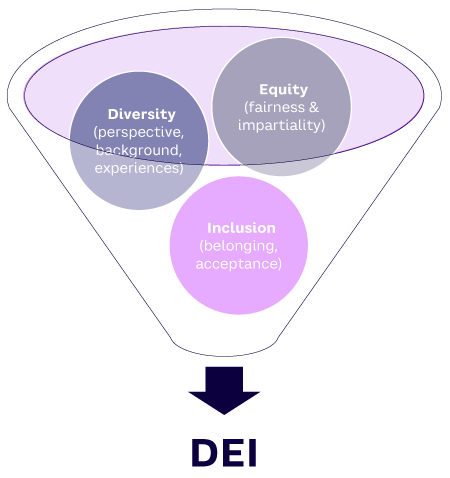AMPLIFY UPDATE VOL. 37, NO. 5

ESG Principles
As most business leaders today understand, ESG is a way to assess the impact of a business’s environmental practices; its relationships with employees, suppliers, customers, and communities; as well as its leadership, reputation, ethics, and risk management. Factors include:
-
Environmental — an organization’s carbon footprint, energy efficiency, waste management practices, and efforts to mitigate climate change
-
Social — the way an organization manages its relationships with stakeholders, such as labor practices, diversity and inclusion, human rights, product safety, and community engagement
-
Governance — relates to structure, leadership, and oversight of a company, including the composition of the board of directors, executive compensation, transparency, ethics, risk management, and regulatory compliance
ESG measures help external stakeholders assess the overall health of the organization. By incorporating ESG factors into budgeting and decision-making, managers can encourage sustainable business practices, reduce risks associated with environmental and social issues, and promote long-term value creation.
Notably, companies that perform well on ESG measures attract more investors and enhance their reputation. Those that neglect ESG principles often face greater examination, reputational damage, and financial risks in the long run.
DEI Principles
DEI is an important component of ESG. It helps companies create a workplace culture where all human resources are valued (see Figure 1):
-
Diversity — acknowledges the range of perspectives, experiences, and backgrounds that individuals bring to the workplace. It considers differences in demographics, life experiences, skills, and perspectives. By promoting diversity, organizations benefit from a wide range of ideas; however, team dynamics play an important role in the implementation of ideas. Although diverse team composition seems to generate a wider range of original and useful ideas, experimental studies suggest that these benefits disappear once the team is tasked with deciding which ideas to select and implement, most likely because diversity hinders consensus.
-
Equity — focuses on ensuring fairness and impartiality in the treatment of all individuals, regardless of background or identity. It involves identifying and addressing systemic barriers that prevent certain groups from fully participating and advancing within the organization. Equity measures seek to provide equal opportunities and access to resources, support, and advancement pathways for all.
-
Inclusion — refers to creating a work environment where all individuals feel valued, respected, and empowered to express their unique perspectives. It involves fostering a sense of belonging and acceptance so that individuals from diverse backgrounds can thrive. Inclusive practices promote open communication, collaboration, and mutual respect among employees at all levels of the organization.

By fostering DEI principles, organizations can cultivate a more favorable and supportive work culture, enhance employee participation and retention, improve idea generation, and increase innovation. As a result, the organization will be able to serve diverse customer bases. DEI initiatives also contribute to broader societal goals, such as promoting social justice, equality, and opportunity for all.
Challenges & Backlash to DEI Initiatives
In the recent push toward ESG/DEI, companies are facing several challenges as they work to embrace DEI, in particular, including:
-
Employee resistance. Implementing DEI requires significant changes to a company’s culture and operations, and employees tend to resist such large-scale shifts. This can stem from a basic human desire to maintain the status quo, but some genuinely fear job loss when faced with diversity initiatives.
-
Lack of understanding. A lack of knowledge about diversity can make leaders hesitant to fully engage in DEI initiatives: they fear making mistakes or being perceived as incompetent. Even leaders who are more comfortable in this area worry that incorporating these strategies will be overly time-consuming or that the initiative will not provide clear returns.
-
Fear of customer backlash. Leaders understandably fear that their DEI efforts will be met with skepticism or outright resistance. Some customers may not agree with a company’s specific DEI approach; others may eschew the idea of DEI altogether.
-
Perceived threat to power and privilege. Often, DEI initiatives are seen as a challenge to the existing leadership power structure, causing people in positions of authority or privilege to feel threatened.
-
Fear of reputational harm. Many leaders worry about the potential for negative publicity or reputational damage if their DEI approach is deemed insensitive or hypocritical.
-
Cultural resistance. Certain cultural norms or societal attitudes can lead to pushback against certain DEI or ESG principles. No matter how diverse the workforce, diversity will not enhance creativity without a culture of knowledge sharing.
-
Lack of leadership support. Middle managers who feel unsupported by top leaders are often reluctant to champion new organizational initiatives, worrying their efforts will not be recognized or rewarded. This can lead to lackluster support for DEI initiatives.
A Holistic Approach to Overcoming Challenges
Addressing these concerns requires strong leadership commitment, adequate resources, leadership diversity, meaningful goals and metrics, training and development, stakeholder engagement, and a deep understanding of the long-term benefits that DEI and ESG initiatives can bring to an organization (e.g., innovation, resilience, and competitiveness):
-
Leadership commitment. Without strong leadership support, DEI initiatives lack the funding, visibility, and accountability they need. Leaders not only set the tone and expectations for these initiatives, they also influence their team’s attitude and determine funding levels.
-
Adequate resources. Organizations that allocate sufficient resources (i.e., funding, time, and people) to support DEI efforts are successful in their DEI initiatives. Organizations must take a systematic approach to mobilizing the resources and capability-building required to deliver on DEI initiatives. They also need to establish routines for monitoring progress over time.
-
Diversity in leadership. The more diverse the leadership team is, the easier it is to create an inclusive organizational culture. Diverse teams bring a treasure trove of perspectives, skills, and experiences, fostering innovation and creativity that leadership can leverage to drive problem-solving. For example, a diversified group of leaders could work to develop and implement inclusive policies to help combat discrimination and overcome resistance from those who believe certain groups are favored over others.
-
Meaningful goals and metrics. Clear goals, benchmarks, and accountability measures make it easier to evaluate the effectiveness of DEI initiatives. For example, the type of candidates your organization attracts reflects quite a bit on your brand, your recruitment processes, and your perceived inclusivity. You can track candidate demographics by looking at the number of candidates in each group as a percentage of total candidates to better estimate whether some groups are disproportionately represented across your organization.
-
Training and development. Adequate training and development opportunities give new employees confidence and encourage a culture of inclusivity but require resources and commitment from leaders and stakeholders.
It’s vital to recognize DEI as a journey rather than a destination and to continuously adapt to the changing environment to facilitate a more inclusive, equitable workplace.
Mitigating Backlash
Explaining to stakeholders precisely how DEI strategies are beneficial to an organization’s overall goals is an excellent way to reduce backlash. For example, leaders can talk about increased employee engagement, improved brand reputation, and reduced risk.
PayPal is a good example of a company with a longstanding, robust commitment to DEI that leaders can point to. It has made building a diverse, inclusive workforce a top priority, including 100% global gender pay equity and US ethnic pay equity. Its efforts include forming partnerships with the Veteran Jobs Mission and AfroTech, as well as supporting numerous employee resource groups.
Netflix is another example of a company that fosters inclusive cultures and supports employee resource groups, emphasizing diversity as a critical component for business success. Its stated goals are to entertain the world by being as innovative and collaborative as possible, which are two of the proven outcomes of a DEI workplace.
A third example is the Ingka Group (owner of IKEA). For the past 10 years, the company has been committed to gender equality across its entire business. Initiatives to achieve gender parity include developing tailored approaches/action plans for each business unit/country, introducing gender-neutral salaries/salary reviews, correcting the pay gap, creating mentorship programs, and developing inclusive succession plans. As a result, Ingka Group achieved 50/50 gender and pay equity across all operations and functions; 48% of its country CEO positions and 50.2 % of its company-wide manager positions are now held by women. Ingka Group will soon launch its “Gender Equality Beyond Binary” approach, which aims to improve and sustain gender balance for trans and non-binary identities across all levels. With this approach, there will be an increased focus on succession, networking, mentoring, caregiving, health, and well-being for all genders.
Lastly, leaders can point to initiatives at Hong Kong Exchanges and Clearing Limited (HKEX). By setting robust disclosure standards, rules, and regulations, HKEX has leveraged its regulatory capabilities to promote strong corporate governance and ESG management. As of 2022, IPO applicants are prohibited from having single-gender boards, and all existing issuers with single-gender boards have until the end of 2024 to appoint a director of a different gender. HKEX also launched a new board diversity repository, which provides transparency on the age, gender, and tenure profile of listed issuers’ board of directors. Beyond these initiatives, HKEX has also partnered with local/global organizations to advocate for diversity in financial markets, launched training courses, published guidance materials to promote diversity, and asked issuers to disclose their diversity policies.
Whenever possible, leaders should provide data demonstrating that implementing DEI can be cost-effective and improve the company’s performance. They can address potential pushback by fully communicating how DEI strategies align with the company’s values and goals. Leaders may want to point to case studies of organizations that have successfully implemented DEI strategies and talk about how this helped them achieve sustainable growth.
Conclusion
Integrating DEI throughout an organization is essential for fostering a culture of belonging, driving innovation, and enhancing overall performance. By positioning DEI within the ESG framework, businesses acknowledge that sustainable practices must prioritize people alongside environmental and governance concerns. This integration highlights the interconnectedness of these elements and emphasizes the importance of addressing social inequalities and promoting inclusive practices as part of corporate social responsibility goals.
Furthermore, when companies align DEI initiatives with corporate responsibility missions, they demonstrate a commitment to social responsibility that goes beyond philanthropy. DEI becomes a core dimension of the company’s values, impacting relationships with employees, customers, and communities.
For example, initiatives such as inclusive hiring practices and community engagement efforts can contribute to meaningful social change while benefiting the company’s reputation and brand. However, to safeguard the company’s reputation, it is essential to proactively address DEI issues. By embedding DEI into corporate governance structures, policies, and procedures, organizations can create a more inclusive and equitable work environment while minimizing legal and compliance risks.
When organizations promote an inclusive culture where diverse perspectives are valued and respected, there is room for creativity, problem-solving, and market insights that lead to positive brand reputation.



